Abstract
We use methods of reverse mathematics to analyze the proof theoretic strength of a theorem involving the notion of coloring number. Classically, the coloring number of a graph is the least cardinal such that there is a well-ordering of for which below any vertex in there are fewer than many vertices connected to it by . We will study a theorem due to Komjáth and Milner, stating that if a graph is the union of forests, then the coloring number of the graph is at most . We focus on the case when .
Citation
Matthew Jura. "Reverse Mathematics and the Coloring Number of Graphs." Notre Dame J. Formal Logic 57 (1) 27 - 44, 2016. https://doi.org/10.1215/00294527-3321905
Information





